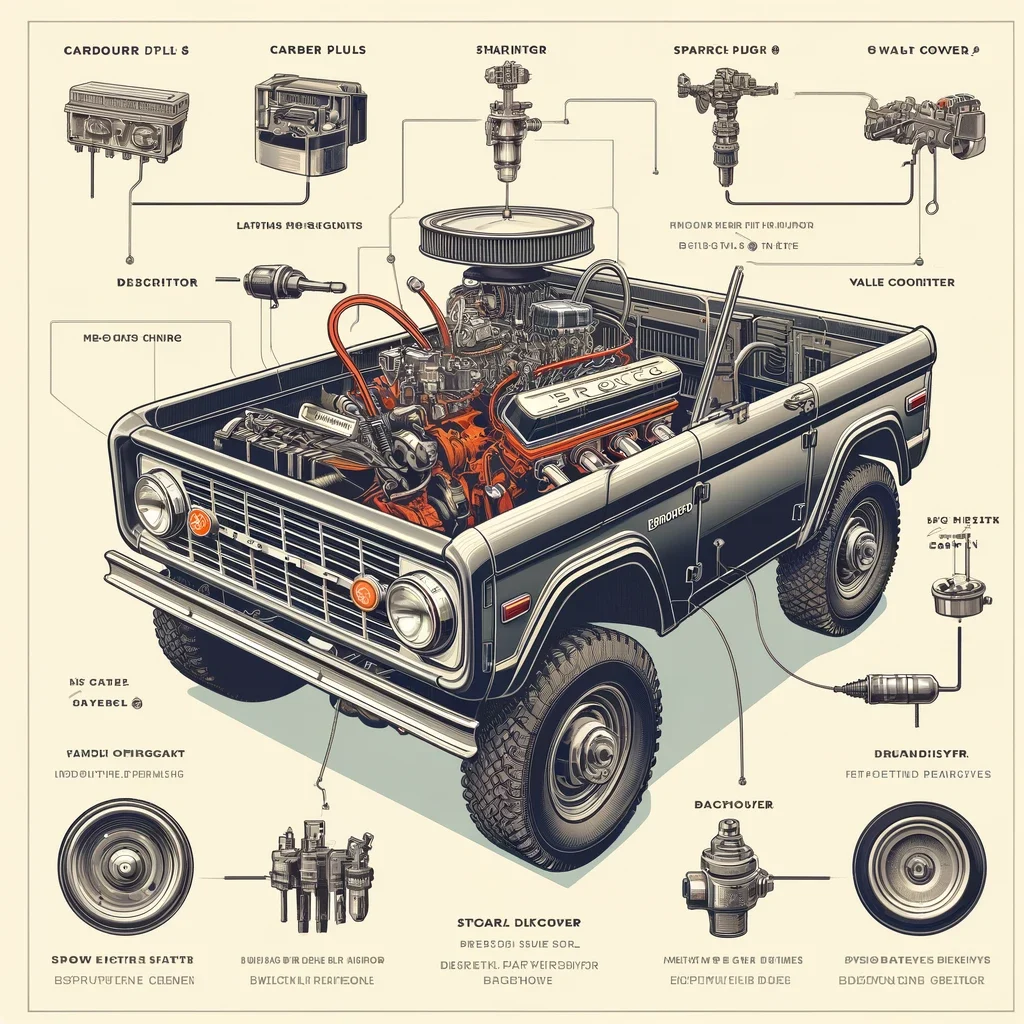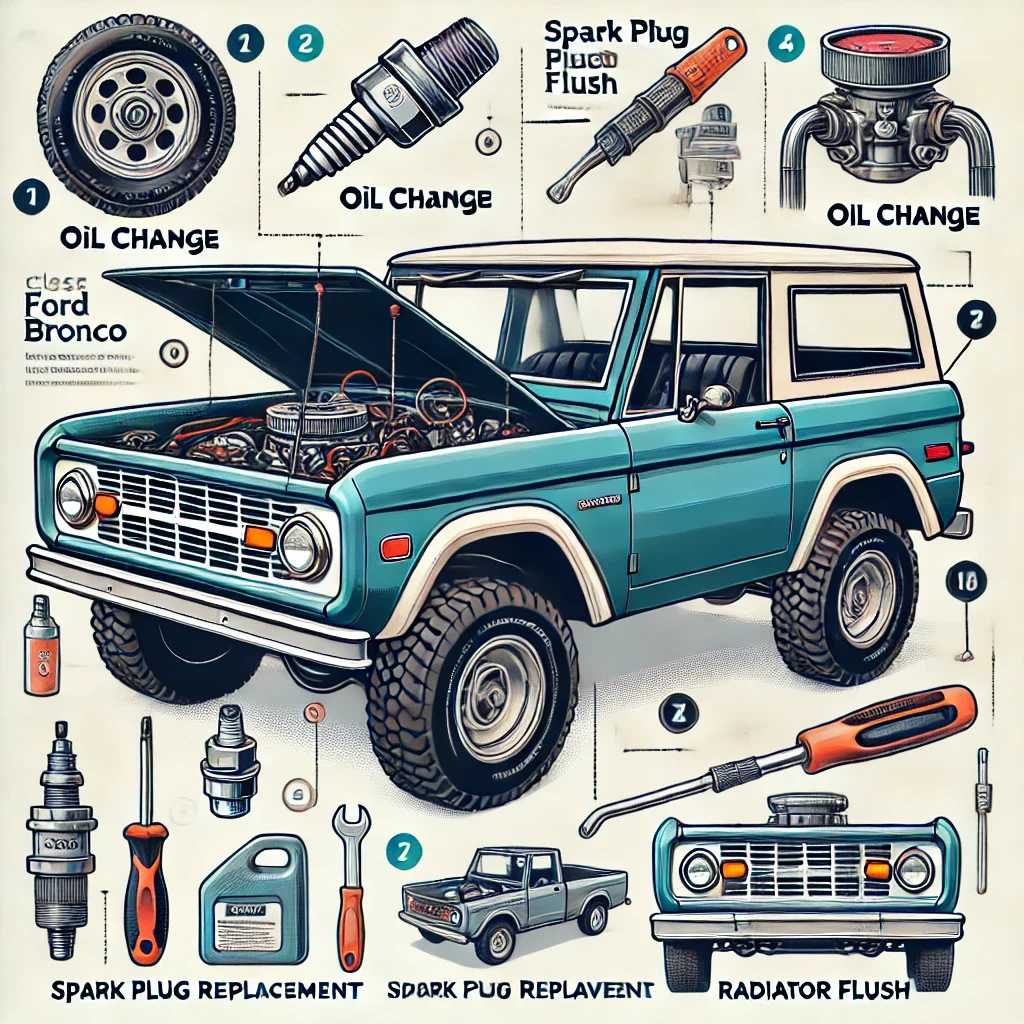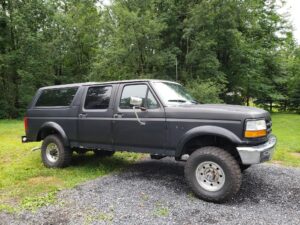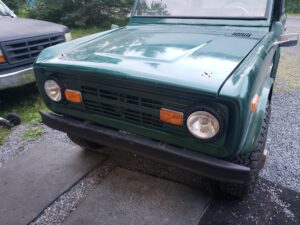Essential Engine Maintenance and Repairs for a Classic Ford Bronco

Introduction
The engine is the heart of any vehicle, and for a classic Ford Bronco (1980-1990), maintaining the engine in top condition is critical for performance and longevity. Whether you’re restoring your Bronco or just keeping it in shape for daily use or off-road adventures, this guide will walk you through essential engine maintenance tasks and common repairs.
1. Key Engine Components
The Ford Bronco is equipped with powerful engines, such as the 302 V8, 351 V8, and 460 V8. Understanding its key components helps in diagnosing and maintaining the engine effectively:
- Internal Components:
- Pistons and Rings.
- Crankshaft.
- Camshaft and Lifters.
- External Components:
- Carburetor (or EFI for later models).
- Intake and Exhaust Manifolds.
- Valve Covers and Gaskets.
- Cooling System:
- Radiator.
- Water Pump.
- Thermostat.
- Ignition System:
- Distributor.
- Spark Plugs and Wires.
- Ignition Coil.
2. Common Engine Problems and Their Solutions
Here are some typical engine problems you may encounter and how to address them:
A. Overheating
- Cause: Clogged radiator, faulty thermostat, or low coolant level.
- Solution:
- Flush the radiator and refill with fresh coolant.
- Replace the thermostat if it’s stuck closed.
- Check for leaks in hoses or the water pump.
B. Poor Performance or Power Loss
- Cause: Dirty carburetor, worn spark plugs, or a clogged air filter.
- Solution:
- Clean and rebuild the carburetor.
- Replace spark plugs and adjust the gap to 0.044 inches.
- Install a new air filter.
C. Oil Leaks
- Cause: Worn valve cover gaskets or oil pan gasket.
- Solution:
- Replace valve cover gaskets using RTV silicone sealant.
- Inspect and replace the oil pan gasket if needed.
D. Hard Starting
- Cause: Weak battery, faulty distributor, or bad ignition coil.
- Solution:
- Test the battery voltage and charge or replace it if necessary.
- Inspect and replace the distributor cap and rotor.
- Check the ignition coil with a multimeter and replace it if faulty.
3. Routine Engine Maintenance
Regular engine maintenance ensures reliability and prevents costly repairs. Follow these essential tasks:
A. Oil and Filter Change
- Change engine oil every 3,000 miles (4,800 km) or 6 months, whichever comes first.
- Use 5W-30 or 10W-40 oil, depending on your climate.
- Replace the oil filter with part number: OF302.
B. Spark Plug Replacement
- Inspect and replace spark plugs every 15,000 miles (24,000 km).
- Recommended spark plugs: SP12C.
- Check the spark plug gap and adjust it to 0.044 inches.
C. Cooling System Maintenance
- Flush the radiator and refill with a 50/50 mix of coolant and water every 2 years.
- Inspect hoses and clamps for leaks or wear.
- Replace the thermostat (part number: T195S) if it’s over 5 years old.
D. Timing Belt or Chain Check
- Inspect the timing chain every 50,000 miles (80,000 km).
- Replace it if there is excessive slack or noise.
4. Engine Rebuilding Tips
If you’re performing a full engine rebuild for your Bronco, here are some important considerations:
- Inspect the Block and Cylinder Heads:
- Check for cracks or warping.
- Machine the block if necessary to ensure a smooth surface.
- Replace Internal Components:
- Install new pistons, rings, and bearings.
- Use high-quality gaskets to ensure a proper seal.
- Upgrade Performance:
- Consider upgrading to a high-performance camshaft or intake manifold.
- Use a 4-barrel carburetor for improved airflow and horsepower.
- Test After Rebuild:
- Perform a compression test to ensure all cylinders are functioning properly.
- Check for oil and coolant leaks before running the engine extensively.
5. Recommended Replacement Parts
Here are some commonly needed engine parts and their part numbers:
- Oil Filter: Part Number: OF302.
- Spark Plugs: Part Number: SP12C.
- Thermostat (195°F): Part Number: T195S.
- Valve Cover Gasket Set: Part Number: VG302.
- Distributor Cap and Rotor: Part Number: DR440.
- Timing Chain Kit: Part Number: TK302.
6. Tools Needed for Engine Maintenance
- Socket wrench set.
- Torque wrench.
- Compression tester.
- Timing light.
- Feeler gauge (for spark plug gaps).
Conclusion
Proper engine maintenance is the cornerstone of preserving your Ford Bronco’s classic charm and performance. By following these tips and addressing issues promptly, you can ensure your engine remains powerful and reliable for years to come. Whether you’re cruising the streets or hitting the trails, your Bronco will always be ready for the journey.



